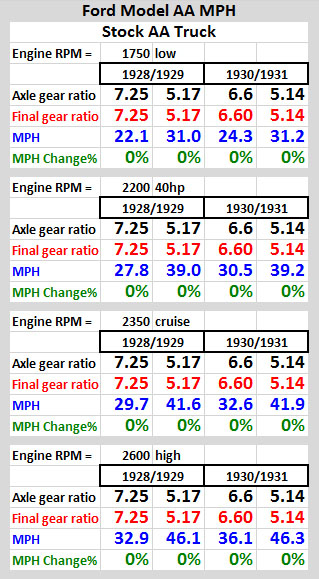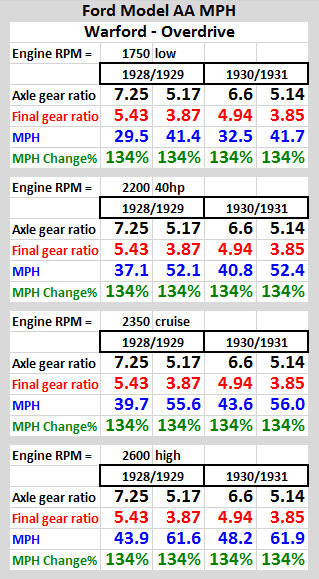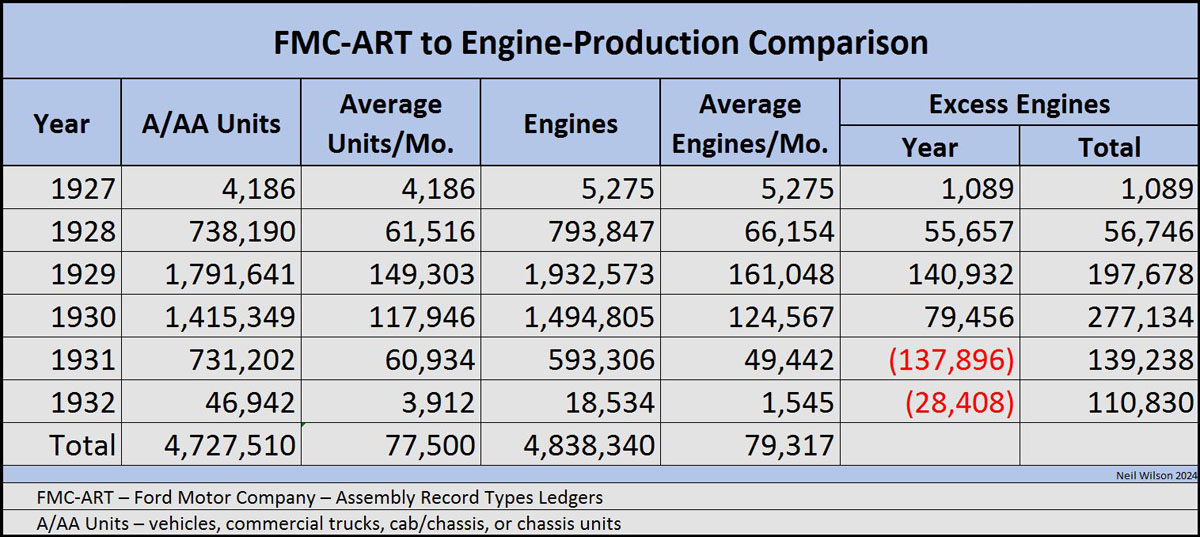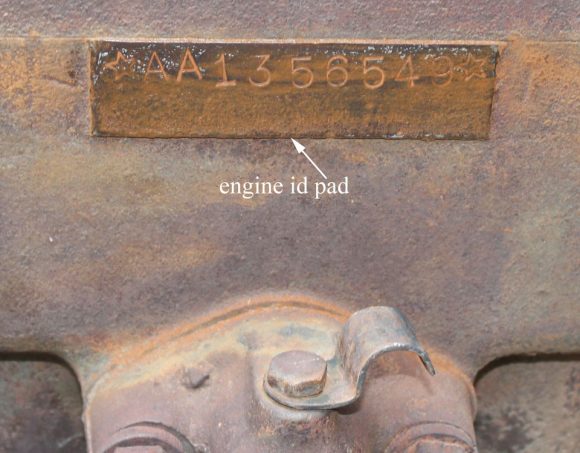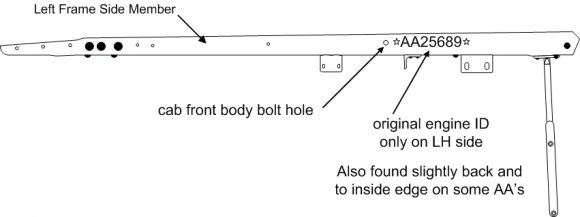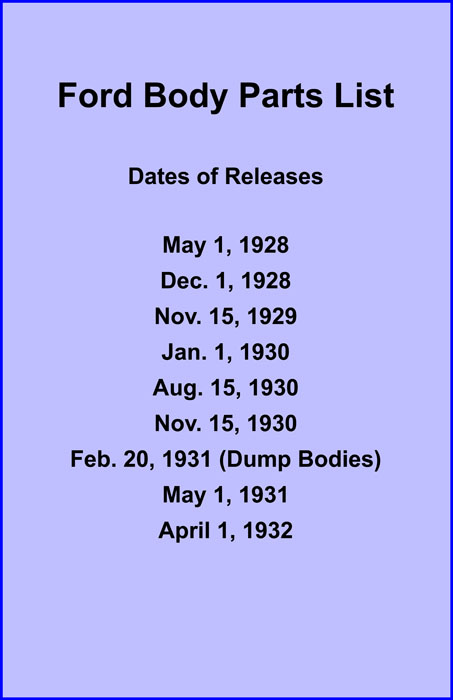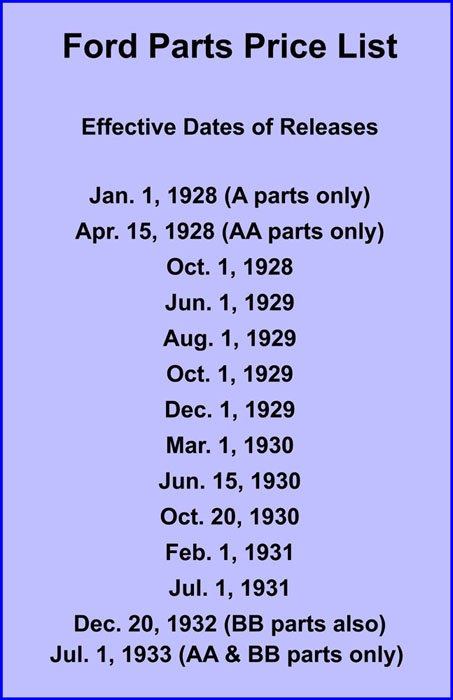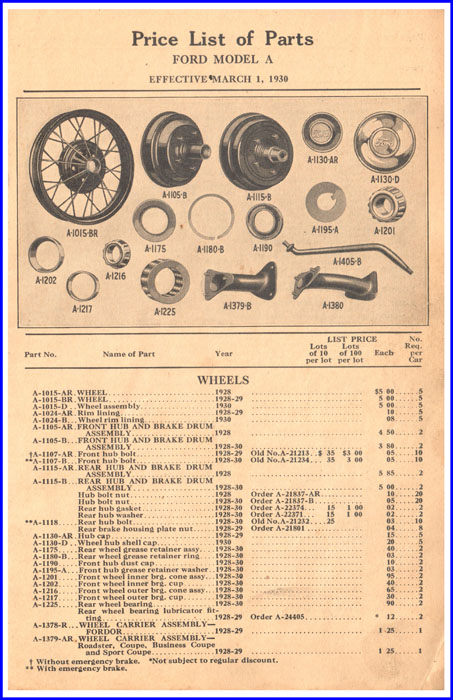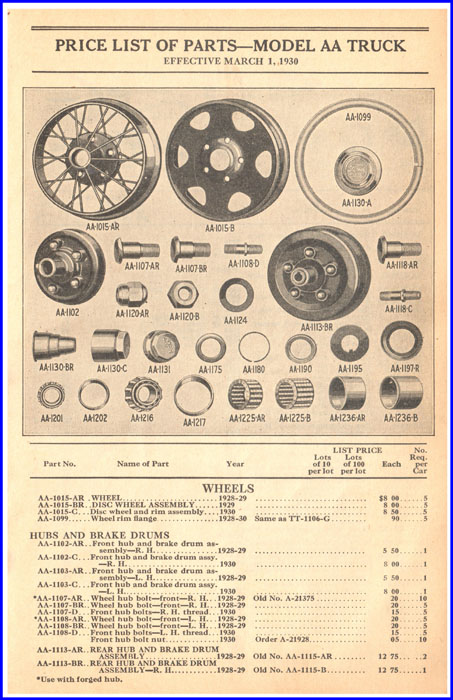2024/10/27 update
Page Contents
Ford AA Truck MPH
The Ford Model AA came with the A chassis engine, A chassis 3-speed or AA 4-speed transmission. The Dual High was an factory option, underdrive for AA’s with the 3-speed transmission. The Warford 3-speed transmission was available as aftermarket equipment (among other suppliers). The AA rear axles came with two gear ratios for all years. Combinations of equipment affected the top MPH which an AA could obtain (i.e. the MPH on a flat surface, no load, no wind resistance, etc.).
For the images below, calculations are based on the transmission in high gear, Warford in overdrive or underdrive, dual-high in underdrive and 6.00×20 tires. Larger tires (like 7.50×20) make very little difference in MPH.
Download the Microsoft Excel work book aa-mph.xlsx to use. The file contains the formulas used. Therefore, values can be changed to show results as desired.
Ford A/AA Production Month
An A/AA month/year production date defines the month a vehicle was driven off the assembly line. This date is actually only a guess determined by researching a given vehicle. Given the Ford information which currently exists, the actual production day cannot be determined.
For MAFCA and MARC judging purposes, a vehicle owner must provide a month/year of the vehicle. Judging is then based on what the owner provides.
For anyone wanting do an off-assembly-line type restoration, a restorer should first research enough to allow for a best-guess of the month/year of a vehicle and then build the vehicle based on that date.
As an example – a 1/30 production AA was an AA which actually drove off the assembly line in January 1930. This date can be used to determine the correct body types and most of the individual chassis parts which would have been used for that given AA originally.
Identifying an A/AA-vehicle by only a year does not offer much in being able to identify original body types or chassis parts. Changes mostly occurred during a given year.
The engine number and/or gas tank date (if present) provides an initial guess of what the year/month would be. See the following.
Engine Number – An A/AA-vehicle engine number only defines the engine run-in test month/year (i.e. the vehicle’s earliest possible production date). However, the actual production date would be days or months after the run-in date. Refer to Monthly Engine Numbers to determine the engine run-in date.
Many A/AA-vehicles have had the engine changed. This makes the engine number useless for original production date determination.
However, the original engine number (+ prefix with a ☆ on either end) was usually stamped on the frame when the engine was installed on the assembly line. See frame engine ID Location.
Due to excess engine production and the large number of engines “in float” between the Rouge plant and the many assembly plants, the numbers can only be used to establish the approximate production date.
For example – by the end of 1930, an engine could have been installed up to four months after the run-in test date (see the comparison table).
Gas Tank Date – There was a date stamped on some gas tank firewall panels (engine side on lower left corner). This date was not an assembly line date.
It is believed that gas tanks were assembled at Fordson plant in Dearborn, MI and date stamped after passing inspection. Another thought is that the date was stamped after delivery to the assembly plant. For sure, the date was stamped before any painting. Obviously, the production date of a vehicle would be after this date (assuming the tank in the vehicle is an original).
New Model-Year-Month – This is assumed to be January. However, Ford documentation identifying the beginning month of each new model-year for A/AA-vehicles has not been found. According to one Internet page, calendar/model-year were synchronized until the mid-1930s. However, this does not work for use in restoring/judging since the month/year is required.
Vehicle Title Year – The model-year on a title is of little value and sometimes is simply a wrong year.
Some states did not have vehicle titles during A/AA production years of 1927—1932 (example – New York started issuing titles in 1973). For states having titles, the determination of a vehicle year was state dependent. For example – A December 1929 production vehicle which was not sold until January 1930 could have been titled a 1930.
Model-Year-Month-Grouping – The RGJS defines “early”, “mid”, and “late” as four-month groupings. However, this does not work for use in restoring/judging since the month/year is required.
A Side Note – In the mid-1930s a government executive order was issued:
Franklin D. Roosevelt signed an executive order that dictated automakers release their new vehicles in the fall of the preceding calendar year “as a means of facilitating regularization of employment in the [automotive] industry.” Auto assembly-line workers are typically idled during a new-model changeover, and the president reasoned that if their idle period were to happen earlier in the fall, autoworkers would be able to maintain employment through the holiday season and would thus be able to spend more money
Ford A/AA Engine ID Makeup
An original engine id was made up of a prefix and a number. The id had a ☆ on each end. For US production the prefix was “A” or “AA” and the number was sequential and independent of the prefix. An example engine id would be ☆AA1356549☆ as shown below. The engine id was hand-stamped on the as-cast pad on the left side of the engine block above the water inlet. Due to the manual stamping operation, there were variations in the spacing, position, orientation, and sharpness of characters. The engine id was specified by Ford as the serial-number in the instruction book. The id usually became the vin# on the title.
Note – The number allows for the identification of the month when a given engine passed an engine run-in test. After stamping, the engine was released for vehicle final assembly. The engine number only dates the final approval of the assembled run-in engine, not the casting dates of the engine components, not the actual assembly date of the engine components, and not the assembly date of the vehicle.
Due to the excess engine production and the large number of engines “in float” between the Rouge plant and the 45 assembly plants in the United States and Europe, the numbers can only be used to establish the approximate production date of a Model A or AA.
By the end of 1930, for example, there were 215,556 excess engines. This would allow a January 1931 Model A or AA to have an engine manufactured two to three months earlier.
| ART – Assembly-Line-Units to Engine Production Comparison | ||||
|---|---|---|---|---|
| Year End | A/AA Units | Engines | Excess Engines | |
| Year | Total | |||
| Neil Wilson 2024 | ||||
| 1927 | 4,186 | 5,275 | 1,089 | 1,089 |
| 1928 | 738,190 | 793,847 | 55,657 | 56,746 |
| 1929 | 1,791,641 | 1,932,573 | 140,932 | 197,678 |
| 1930 | 1,415,349 | 1,494,805 | 79,456 | 277,134 |
| 1931 | 731,202 | 593,306 | -137,896 | 139,238 |
| 1932 | 46,942 | 18,534 | -28,408 | 110,830 |
| Total | 4,727,510 | 4,838,340 | 110,830 | 110,830 |
| AAAAAA | AAAA-AAAAA | AAAA-AAAAA | AAAA-AAAAA | AAAA-AAAAA |
| A/AA Vehicle to Engine Production Comparison | ||||
|---|---|---|---|---|
| Year End | Vehicles | Engines | Excess Engines | |
| Year | Total | |||
| Neil Wilson 2014 | ||||
| 1928 | 738,936 | 804,847 | 65,911 | 67,000 |
| 1929 | 1,863,295 | 1,932,573 | 69,278 | 136,278 |
| 1930 | 1,415,527 | 1,494,805 | 79,278 | 215,556 |
| 1931 | 732,199 | 593,306 | -138,893 | 76,663 |
| Total | 4,754,143 | 4,830,806 | 76,663 | 76,663 |
| AAAAAA | AAAA-AAAAA | AAAA-AAAAA | AAAA-AAAAA | AAAA-AAAAA |
Most of the time, at individual assembly plants where each engine was installed, the id was also stamped on top of the frame’s left hand side member near the clutch petal as shown below. With the body or cab mounted, the id on the frame could not be seen.
The “AA” prefix identified engines slated for use in an AA. These assemblies had a stronger clutch spring (AA-7556) for multiple-disc clutch units, AA-7563 clutch pressure plate and cover assembly for single-disc clutch units, or units with the 4-speed transmission and clutch. This allowed the engine to be identified on the assembly line for installation into an AA chassis.
Note – For about 2-1/2 months, starting mid February 1928 (with engine ID A-26268), the AA’s used the same multiple-disc clutch spring as was used for the A chassis. Consequently, during this period, the engine ID had an “A” prefix. Refer to the “Indianapolis Service Letters” dated February 23rd and May 15th 1928. An AA with engine and frame ID of AA-98977 has been found. This is a late April 1928 number and helps define the end of the “A” prefixed ID’s for the AA’s.
Frame Engine ID Location
Monthly Engine Numbers
| Month | First # | Last # | Total # |
|---|---|---|---|
| Neil Wilson 2018 | |||
| Oct-27 | 1 | 137 | 137 |
| Nov-27 | 138 | 971 | 834 |
| Dec-27 | 972 | 5,275 | 4,304 |
| 1927 Year End Total | 5,275 | ||
| Jan-28 | 5,276 | 17,251 | 11,976 |
| Feb-28 | 17,252 | 36,016 | 18,765 |
| Mar-28 | 36,017 | 67,700 | 31,684 |
| Apr-28 | 67,701 | 109,740 | 42,040 |
| May-28 | 109,741 | 165,726 | 55,986 |
| Jun-28 | 165,727 | 224,276 | 58,550 |
| Jul-28 | 224,277 | 295,707 | 71,431 |
| Aug-28 | 295,708 | 384,867 | 89,160 |
| Sep-28 | 384,868 | 473,012 | 88,145 |
| Oct-28 | 473,013 | 585,696 | 112,684 |
| Nov-28 | 585,697 | 697,829 | 112,133 |
| Dec-28 | 697,830 | 810,122 | 112,293 |
| 1928 Year End Total | 804,847 | ||
| Jan-29 | 810,123 | 983,136 | 173,014 |
| Feb-29 | 983,137 | 1,127,171 | 144,035 |
| Mar-29 | 1,127,172 | 1,298,827 | 171,656 |
| Apr-29 | 1,298,828 | 1,478,647 | 179,820 |
| May-29 | 1,478,648 | 1,663,401 | 184,754 |
| Jun-29 | 1,663,402 | 1,854,831 | 191,430 |
| Jul-29 | 1,854,832 | 2,045,422 | 190,591 |
| Aug-29 | 2,045,423 | 2,243,920 | 198,498 |
| Sep-29 | 2,243,921 | 2,396,932 | 153,012 |
| Oct-29 | 2,396,933 | 2,571,781 | 174,849 |
| Nov-29 | 2,571,782 | 2,678,140 | 106,359 |
| Dec-29 | 2,678,141 | 2,742,695 | 64,555 |
| 1929 Year End Total | 1,932,573 | ||
| Jan-30 | 2,742,696 | 2,826,649 | 83,954 |
| Feb-30 | 2,826,650 | 2,940,776 | 114,127 |
| Mar-30 | 2,940,777 | 3,114,465 | 173,689 |
| Apr-30 | 3,114,466 | 3,304,703 | 190,238 |
| May-30 | 3,304,704 | 3,509,306 | 204,603 |
| Jun-30 | 3,509,307 | 3,702,547 | 193,241 |
| Jul-30 | 3,702,548 | 3,771,362 | 68,815 |
| Aug-30 | 3,771,363 | 3,883,888 | 112,526 |
| Sep-30 | 3,883,889 | 4,005,973 | 122,085 |
| Oct-30 | 4,005,974 | 4,093,995 | 88,022 |
| Nov-30 | 4,093,996 | 4,177,733 | 83,738 |
| Dec-30 | 4,177,734 | 4,237,500 | 59,767 |
| 1930 Year End Total | 1,494,805 | ||
| Jan-31 | 4,237,501 | 4,310,300 | 72,800 |
| Feb-31 | 4,310,301 | 4,393,627 | 83,327 |
| Mar-31 | 4,393,628 | 4,520,831 | 127,204 |
| Apr-31 | 4,520,832 | 4,611,921 | 91,090 |
| May-31 | 4,611,922 | 4,695,999 | 84,078 |
| Jun-31 | 4,696,000 | 4,746,730 | 50,731 |
| Jul-31 | 4,746,731 | 4,777,282 | 30,552 |
| Aug-31 | 0 | ||
| Sep-31 | 4,777,283 | 4,824,809 | 47,527 |
| Oct-31 | 4,824,810 | 4,826,746 | 1,937 |
| Nov-31 | 4,826,747 | 4,830,806 | 4,060 |
| Dec-31 | 0 | ||
| 1931 Year End Total | 593,306 | ||
| Jan-32 | 4,830,807 | 4,842,983 | 12,177 |
| Feb-32 | 4,842,984 | 4,846,691 | 3,708 |
| mid Mar-32 | 4,846,692 | 4,849,340 | 2,649 |
| 1932 Year End Total | 18,534 | ||
| AAAAAA | AAAAAAA | AAAAAAA | AAAAAAA |
Check out the Links page for other sites with expanded details regarding the engine id.
Ford A/AA Parts ID Makeup
Ford issued various parts booklets to dealers during the A/AA production. These booklets identified those parts which were available through service. Many of the parts listed were also the parts being used at the Ford assembly plants at the time of the booklet’s release. Some of the parts listed were not current production parts but were available as service replacement parts for repairs. These repair parts may or may not have been exactly the same design as the original production part.
Parts were assigned an id consisting of three items – chassis-model-prefix, number, design-suffix (like AA-1015-B). These three id-items are described as:
Part chassis-model-prefix – “A” or “AA” – “AA” was the prefix used for those parts which were only used on the Model AA vehicles. Parts used on both the A and AA were assigned an “A” model prefix. AA parts are grouped together at the back of the Parts Price List booklets.
Part number – a number which allowed parts to be grouped. Example – the transmission and clutch parts group was 7000-7999.
Part design-suffix – none or letter as follows:
no-design-suffix (i.e. blank) – an initial unique production design part. Example – part “AA-1015 – wheel” was the first production wheel design used for the model AA and carried no-suffix (no other AA wheel existed at the time this steel spoke wheel was used in production). Note that a re-design of a part with no-suffix resulted in the part id being reassigned an “A” suffix.
letter-design-suffix (such as A, B, C, D, etc. but excluding “R”) – a non-unique part:
Example 1 – part “A-13010-A – head lamp case and support assembly (nickel)” and “A-13010-B – head lamp case and support assembly (black)”. Both of these acorn shaped headlamp cases were used in production at the same time and therefore each was assigned design-suffix for identification.
Example 2 – part “AA-1015-B – wheel” was the new model AA disk wheel design released in February 1929 (replacing the prior steel spoke wheel). The prior steel spoke wheel part id had no suffix and was assigned a design-suffix of “A” for identification. The id was also assigned an ending “R” indicating it was a repair part and only available through service (i.e. not a production wheel). So, the steel spoke wheel part id became AA-1015-AR in the first 1929 Parts Price List booklet.
The special “R” parts suffix (Repair Parts)
R-suffix (Repair Part) – Any part id with an “R” in the suffix indicates that it was a repair part (i.e. an after-production part which was not used in current production but was available through service for repairs). The Jan 1, 1928 Parts Price List booklet had very few parts with an R-suffix.
One example of an exception to this rule was the worm drive rear axle. Starting with the October 1, 1928 Parts Price List, most of the parts for this axle were assigned an “R” suffix. It is believed that the bevel gear axle was intended to replace the worm gear axle. However, this didn’t happen but the “R” was never removed from the worm gear axle part id’s.
Some repair parts were modified and consequently were different from the original assembly line design. An example is 1928/1929 frame front cross member AA-5020-AR. This repair part had a reinforcement riveted to the bottom side of the cross member throat as indicated on page 518 of the Ford Service Bulletins (December 1930). Trucks having this after-production repair part would not be assembly line original .
Notes about the Part ID suffix
design-suffix note 1 – new suffix letters (such as A, B, C, D) were not assigned to redesigned parts which were backward compatible with the prior part. The new part was simply placed into production using the prior part id. Example – the 1930/1931 AA wheels had four designs but the wheel id remained AA-1015-C for all four designs. Each of these designs can only be dated through the use of Ford records, engineering drawings, Service Bulletins, Branch letters and observations of original AA’s.
design-suffix note 2 – Some no-suffix parts were obsoleted without having a similar replacement and therefore only had an “R” suffix. Example – part “A-2473 Brake equalizer operating shaft pin” was eliminated as a result of a new brake system design. The obsoleted part became “A-2473-R Brake equalizer operating shaft pin”. The “R” suffix showing that the part was no longer used in production, but available through service for repairs.
Ford Body Parts List Booklets
Ford issued a number of releases of a “Body Parts List” booklet (5.5″ x 8.5″) covering the A and AA bodies. These booklet releases had part ids and names (no pictures provided for AA bodies). These booklet releases are not easy to use but offer lots of good information for research and for determining the original Ford name for parts.
The first two booklet releases were titled “Price List of Body Parts”. The May 1, 1928 booklet had prices on each part line. These Dec. 1, 1928 booklet included both a body parts and a price list section. Subsequent releases were titled “Body Parts List”. A separate booklet provided the price list by part.
Ford Chassis Parts Lists (Parts Price List Booklets)
Ford issued a number of releases of a “Parts Price List” booklet (5.5″ x 8.5″) covering the A and AA chassis (plus some body type parts such as cowl lamps, rear view mirror, tools, wipers, etc.). Booklets had three sections (Model A, Standard Parts, and Model AA). Each booklet release contained a list of those parts available through service as of the cover date. Included were both current production parts and service only parts (i.e. parts not currently in production). Many parts were assemblies. Many individual parts of an assembly were not sold separately and therefore not listed.
Note that the first release of this booklet (January 1, 1928) did not include any AA parts. An April 15, 1928 release covered the AA only. Thereafter, each release had both the A and AA. Pictures of many of the parts are also shown in these booklet releases.
Each booklet section is subdivided into part groupings (such an Wheels, Service Brakes, etc.). The part listing within the A and AA sections shows the part id, part name/description, price, and number per car (i.e. vehicle). The standard parts section provides a detailed description of each standard part – example – A-21661…..1/4-20 U.S.S. (9/16 x 1/2) sq. nut.

